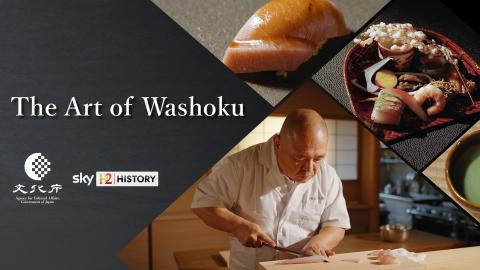Uncovering Obama city’s unique Japanese food culture and traditions
SPONSORED ARTICLE
Sky HISTORY has partnered up with the Japan Ministry of Culture to bring you a series of articles that explore the history and food culture of The Saba Kaido – or 'Mackerel Highway' – a network of roads that connects Kyoto to the shimmering waters of the Wakasa Bay and the historic port town of Obama.
The city of Kyoto is undoubtedly one of the great cultural capitals of Japan. But anyone visiting its famous temples and gardens may also want to go a little further afield, to discover a fascinating place that just happens to share its name with an American president. The nearest seaside north of Kyoto, Wakasa Obama was a crucial seaport of the Edo Period (1603-1868), when both domestic and international trading ships loaded with food and other cargo would come into scenic Wakasa Bay.
But Obama City’s historical significance actually goes back even further, to the 8th Century. This was when the quality of the local seafood, sea salt and other culinary delights brought the historic province of Wakasa (where Obama sits) to the attention of the Imperial court in Kyoto. The area became known as a Miketsukuni – an officially ordained source of prized ingredients for the nation’s rulers. These ingredients, including fish sourced from the sparkling waters of Wakasa Bay, were transported on foot or horseback to Kyoto by a number of mountainous routes. Collectively known as the Saba Kaido, or Mackerel Highway, the lush, scenic, centuries-old paths can still be walked by hikers today.
There are a number of must-see places within Obama City itself that shed a light on the culinary and cultural history of the area. Here are some that should be on any visitor’s to-do list.
The Miketsukuni Wakasa Obama Food Culture Museum
Obama City has a particular attraction for foodies – particularly lovers of fish. You can delve into its culinary heritage at the Miketsukuni Wakasa Obama Food Culture Museum, which has exhibits exploring the region’s time as a purveyor of produce for Japan’s emperors. You’ll learn about how the Mackerel Highway came to be, and follow the sometimes surprising evolution of sushi, which has its origins in narezushi – a rather more intimidating dish made using fish that has been painstakingly fermented for at least a year (in Wakasa, the local narezushi is made using mackerel, of course). There’s even a kitchen studio, where you can take part in cookery lessons using ingredients sourced from the bay, and a workshop where you can try your hand at making traditional items associated with Obama, including the city’s famous lacquered chopsticks.
Sanchomachi
You can immerse yourself in Obama’s history in Sanchomachi, which was once the city’s geisha district. It’s been impeccably preserved, almost serving as an architectural time capsule for the Wakasa region. Here, you can wander by the lattice-work facades of wooden townhouses, and perhaps pay a visit to Harima. This restaurant is the last remaining establishment keeping the age-old traditions of this neighbourhood alive. Geisha entertain guests with songs and games, while classic, multi-course, kaiseki feasts showcase the ingredients of Wakasa.
Wakasa Obama Fish Center
As Obama is practically synonymous with the Mackerel Highway, it’s no surprise that many visitors are drawn to the Fish Center. It’s a bustling market where you can get a first hand look at the wares that have made the region famous for well over a thousand years. Fresh off the local boats, fish glisten in a rich array of colours, ready to be picked up by restaurateurs and private buyers alike. If that has you feeling peckish, you’ll be able to sample some of the famous mackerel for yourself, with vendors selling hamayaki saba: mackerel that is skewered whole and grilled to crispy, bronzed, succulent perfection.
Myotsuji Temple
Obama is a city of temples, and perhaps the most iconic is Myotsuji. Nestled amid cypress trees, this Shingon Buddhist landmark is thought to date back to 806 AD and still provides a serene refuge from the cares of urban life today. It’s said the temple was founded by famed shogun Sakanoue no Tamuramaro. As the story goes, he was inspired by a divine vision which led him to the location where the temple was erected. Today, you can see 11th and 12th Century statues carved in honour of the original versions that Sakanoue no Tamuramaro himself made. Other marvels include a three-story pagoda which dates to the 13th Century, and a wooden gate which was made as “recently” as 1772.
Omizo Okuri
The Omizo Okuri “water sending” festival is held every March 2nd and is one of the most celebrated and spectacular events in the city’s calendar. The focus of the festival is the Wakasa Jingu-Ji shrine, whose history goes back 1,300 years. During the festival, you can observe archery demonstrations on the temple grounds, and watch monks and hundreds of other participants light torches on a bonfire and embark on an enchanting, fiery procession to a local river. Here, elaborate purification rituals unfold before holy water is poured into the river. It is believed that the water will eventually reach the city of Nara exactly 10 days later, at which point a corresponding “water drawing” festival takes place.
Whether you spend time exploring the food history, visiting the temples and shrines, or sampling the iconic mackerel dishes, Obama City provides a tranquil, coastal counterpoint to the more well-known spectacle of Kyoto.
















